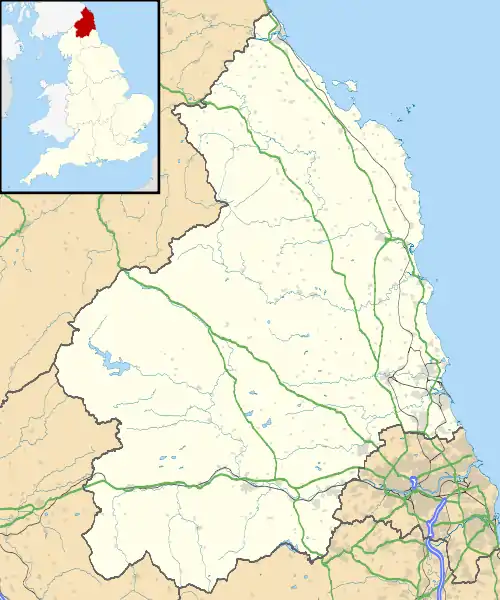Farne Lighthouse
Farne Lighthouse is a lighthouse on the southern tip of Inner Farne (one of a group of islands off the coast of North Northumberland). Built in the early 19th century, it still functions as a lighthouse and is managed by Trinity House (England's general lighthouse authority). In 1910 it was one of the first Trinity House lighthouses to be automated.[3]
 Farne Lighthouse | |
 Northumberland | |

| |
| Location | Farne Islands Northumberland England |
|---|---|
| Coordinates | 55°36′55.3″N 1°39′20.6″W |
| Year first constructed | 1776 (first) |
| Year first lit | 1811 (current) |
| Automated | 1910 |
| Construction | brick tower |
| Tower shape | cylindrical tower with balcony and lantern |
| Markings / pattern | white tower and lantern |
| Tower height | 13 m (43 ft) |
| Focal height | 27 m (89 ft) |
| Original lens | 1st order catadioptric fixed lens |
| Intensity | white: 1,650 candela red: 208 candela |
| Range | white: 10 nmi (19 km; 12 mi) red: 7 nmi (13 km; 8.1 mi) |
| Characteristic | Fl (2) WR15s. |
| Admiralty number | A2812 |
| NGA number | 2256 |
| ARLHS number | ENG 060 |
| Managing agent | National Trust (Farne Islands National Nature Reserve)[1][2] |
| Heritage | Grade II listed building |
History
Farne Lighthouse was one of a pair built on Inner Farne by the Corporation of Trinity House in 1811, both of which were designed by Daniel Alexander to replace an earlier coal-burning light which had been established on the island by Captain John Blackett in 1778.
Farne Lighthouse (originally named Farne High Lighthouse) is a cylindrical white tower, 13 m (43 ft) tall with a lighthouse keeper's cottage attached to its base. It was initially provided with a revolving array of seven Argand lamps and reflectors, which displayed a single white flash every 30 seconds. In 1910 it was converted to run automatically on acetylene (manufactured in an adjacent producer plant and controlled by a sun valve);[4] a new fixed optic was installed in the lantern and a red sector was added to the main light to indicate lines of approach that were hazardous for shipping.[5] (That same year saw the nearby Bamburgh Lighthouse established, with a sector light that worked in conjunction with the Inner Farne light.[5]) This arrangement largely remains in place, except that in 1996 the light was converted from acetylene to solar powered operation.[4]
The other lighthouse on the island (Farne Low Lighthouse) was an octagonal tower, 8 m (26 ft) tall, placed 150 m (490 ft) away from the first, close to the north-west tip of the island. It served to warn shipping of the Megstone, an isolated rocky island lying (in line with the two lights) just under a mile away to the north-west.[6] Whereas the High Light revolved, the Low Light showed a fixed beam from a single Argand lamp and reflector;[7] it was monitored by the keeper at the High Lighthouse, the light being made visible through a small aperture in the rear of the Low Lighthouse.[8]
After the High Light had been modified and automated in 1910, use of the Low Light was discontinued; before long it was demolished along with most of the keepers' accommodation (which was now no longer needed).[7]
Associated lighthouses
In 1811, at the same time as it was building the two lighthouses on Inner Farne, Trinity House also built a new lighthouse on one of the outer Farne Islands: Brownsman Island. This light was also designed by Daniel Alexander and was similar to the other two in appearance and layout but taller;[9] it too was equipped with a revolving set of lamps and reflectors.[10] It likewise replaced an earlier light built by Captain Blackett in 1778 (on nearby Staple Island, but subsequently relocated to Brownsman).[7] The 1811 installation on Brownsman Island was itself later moved to a more effective position on Longstone Island, further out to sea; as Longstone Lighthouse it too remains active as an aid to navigation for Trinity House.
Present day
The tower is 13 m (43 ft) tall with a range for the white light of 10 nautical miles (19 km; 12 mi) and the Red 7 nmi (13 km; 8.1 mi). Farne Island Lighthouse was sold on 6 June 2005 to the National Trust for £132,000; nevertheless it remains an operational lighthouse, with relevant areas of the building having been leased back to Trinity House for a peppercorn rent.[11] After a 2015 review the lighthouse was equipped with an LED lantern.[12]
Notes
- Inner Farne (High) The Lighthouse Directory. University of North Carolina at Chapel Hill. Retrieved 1 May 2016
- Farne Island Lighthouse Trinity House. Retrieved 1 May 2016
- Jones, Robin (2014). Lighthouses of the North East Coast. Wellington, Somerset: Halsgrove. p. 28.
- "Farne Lighthouse". Trinity House. Archived from the original on 10 March 2013.
- "Farne Lighthouse". Worldwide Lighthouses. Retrieved 26 February 2019.
- "Lighthouses on the Farne Islands". National Trust. Retrieved 26 February 2019.
- Middleton, Penny. "Historic Environment Survey for the National Trust: The Farne Islands" (PDF). Archaeo-Environment Ltd. Retrieved 26 February 2019.
- Elliot, George H. (1875). European Light-House Systems. London: Lockwood & co. p. 130. Retrieved 10 March 2019.
- Original design: elevation.
- Original design: section.
- "The General Lighthouse Fund 2004-2005" (PDF). The Stationery Office. Retrieved 21 January 2020.
- "Farne Island Lighthouse". Trinity House. Retrieved 22 February 2019.